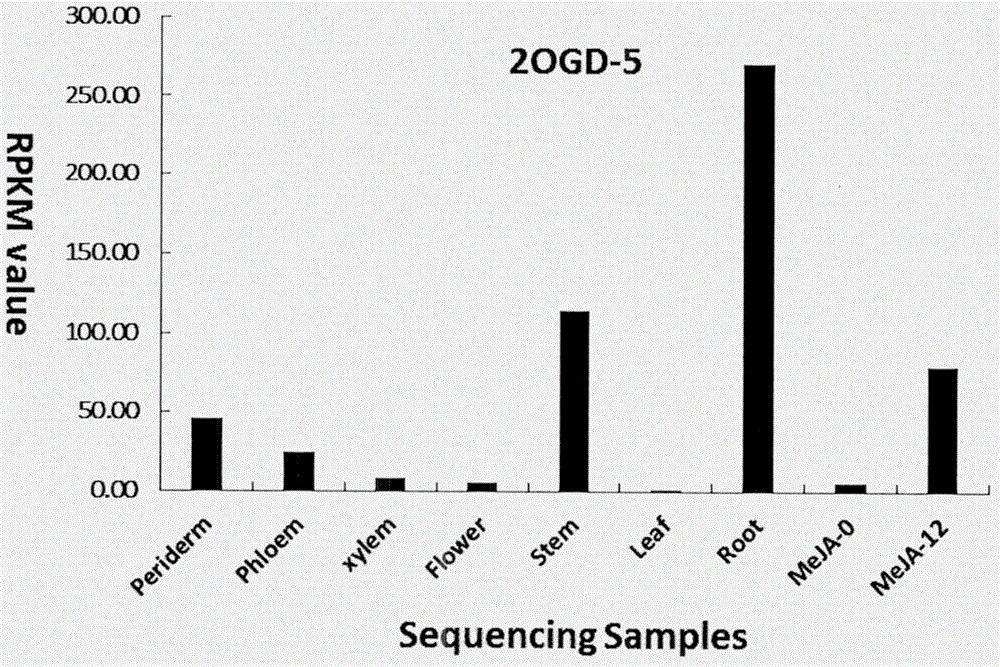Clone identification and application of 2-oxoglutarate-dependent dioxygenase (2OGD-5) gene participating in tanshinone synthesis
A technology of ketoglutaric acid and dioxygenase, which is applied in the fields of application, genetic engineering, oxidoreductase, etc., and can solve the problems of unknown biosynthesis
- Summary
- Abstract
- Description
- Claims
- Application Information
AI Technical Summary
Problems solved by technology
Method used
Image
Examples
Embodiment 1
[0018] Example 1 Genome-wide Screening of Danshen 2OGD Family
[0019] 1) Based on the whole genome scan of Danshen 2OG-FeII_Oxy domain (PF03171), 132 members of the 2OGD superfamily of Danshen were screened, and the amino acid sequence length distribution ranged from 120aa to 504aa.
[0020] 2) Using MEGA alignment and constructing a phylogenetic tree, the Salvia miltiorrhiza 2OGD superfamily is divided into two subfamilies, DOXB and DOXC, in which DOXB contains 14 2OGD members, and DOXC contains 116 2OGD members, such as figure 1 shown.
[0021] 3) Collect transcriptome sequencing data of different organ tissues and treatments of Danshen, and use Tophat and Cufflinks software to analyze the differential expression profiles of 2OGD members of Danshen under different organ tissues and MeJA treatment, as shown in figure 2 shown.
[0022] 4) According to the synthesis and accumulation of tanshinone in different parts of Danshen, screen the 2OGD family members with consistent ...
Embodiment 2
[0023] Example 2 Cloning and structural analysis of the gene encoding Salvia miltiorrhiza 2OGD-5
[0024] 1) Align the 2OGD-5 sequences screened in Example 1 to design full-length primers, perform PCR amplification from the cDNA of Danshen root, and obtain a 1089bp nucleotide sequence, such as SEQ ID No.1. According to the translation of the full-length cDNA sequence, the amino acid sequence of Danshen 2OGD-5 was deduced, with a total of 362 amino acid residues, such as SEQ ID No.2.
[0025] 2) Use PyMOL software to predict the protein structure of 2OGD-5, referring to the protein three-dimensional structure model of Arabidopsis AtLDOX (PDBID: 1GP5), such as Figure 4 shown.
Embodiment 3
[0026] Example 3 Salvia miltiorrhiza 2OGD-5 functional identification
[0027] 1) Gateway primer design and fragment amplification. A 186bp RNAi fragment primer was designed for the 2OGD-5 gene (gene position: 304-489bp), and the attB1 sequence: GGGGACAAGTTTGTACAAAAAAGCAGGCT was added to the 5' end, and the attB2 sequence GGGGACCACTTTGTACAAGAAAGCTGGGT was added to the 3' end. When designing RNAi primers, in order to avoid the poor specificity of the designed RNAi region resulting in multiple transgene silencing targets, the RNAi region of each gene was compared with the genome BLAST, and the RNAi region with the best specificity was selected. The primer sequence is as follows:
[0028] F-GGGGACAAGTTTGTACAAAAAAAGCAGGCTCCCTCGGAGACGATGGACG
[0029] R-GGGGACCACTTTGTACAAGAAAGCTGGGTGTCGTCGCTGAAGACGCAC
[0030] 2) Gateway constructs RNAi vector. BP reaction: take 25ng of attB PCR recovery product and 75ng pDONR221 entry vector, add water and mix to 4 μL, then add 1 μL of BPclonase...
PUM
 Login to View More
Login to View More Abstract
Description
Claims
Application Information
 Login to View More
Login to View More - R&D
- Intellectual Property
- Life Sciences
- Materials
- Tech Scout
- Unparalleled Data Quality
- Higher Quality Content
- 60% Fewer Hallucinations
Browse by: Latest US Patents, China's latest patents, Technical Efficacy Thesaurus, Application Domain, Technology Topic, Popular Technical Reports.
© 2025 PatSnap. All rights reserved.Legal|Privacy policy|Modern Slavery Act Transparency Statement|Sitemap|About US| Contact US: help@patsnap.com



